Monday Mar. 10, 2008
Quiz #2 is Wednesday this week. The Quiz
#2 Study Guide is still available online.
The 3rd Optional Assignment was collected in class today. A sheet
with answers to the questions was distributed in class.
You'll find answers to previous "in-class" and "hidden" optional
assignments online (go back to the class home page).
The Expt. #2 reports have been graded (after a superhuman effort) and
were returned in class. You are allowed to revise your
reports. The revised reports are due on or before Wed., Mar. 26
(the Wednesday after Spring Break).
The Experiment #4 materials were also
handed out in class. There are still several sets of Expt. #4
materials (and some Expt. #3 materials)
available. They'll be back in class on Wednesday. You
should already have done an experiment or be working on an experiment
(or book report). If you haven't you should check out the
necessary materials this week.
Don't forget that the 1S1P Assignment #2
reports (and optional worksheets) are due this week. If you don't
turn in your report in class you will need to bring it by my office
(PAS 588) by the end of the day on Friday.
We'll wrap
up the section on radiative equilibrium and the atmospheric greenhouse
effect and start some new material today.
You can
use the simplified picture of radiative equilibrium to understand the
effects of clouds on nighttime low and
daytime high temperatures. You'll find this discussed on pps 72a
and
72b in the Classnotes.

Here's the simplified picture of radiative equilibrium (something
you're probably getting pretty tired of seeing). By now you
should be able to identify each of the colored arrows in the figure
above and explain what they represent.
The two pictures below show what happens at night when you remove
the
two green rays of incoming sunlight.
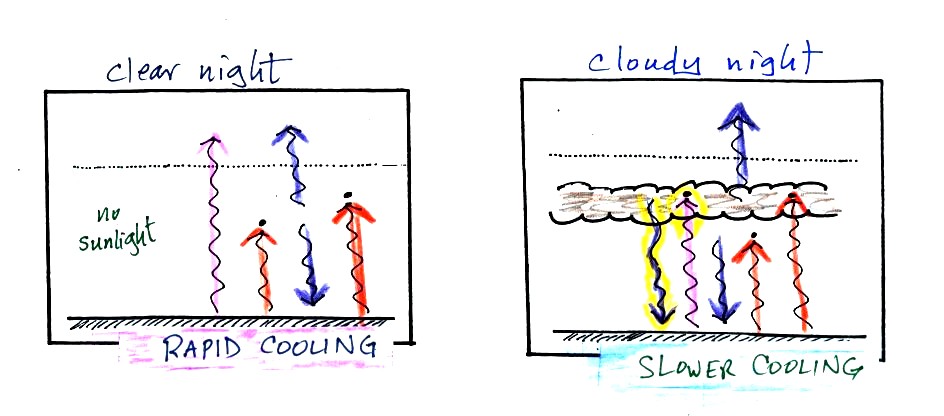
The picture on the left shows a clear night. The ground is losing
3
arrows of energy and getting one back from the atmosphere. That's
a
net loss of 2 arrows. The ground cools rapidly and gets cold
during
the night.
A cloudy night is shown at right. Notice the effect of the
clouds.
Clouds are good absorbers
of infrared
radiation. If we could see IR light,
clouds would appear black, very different from what we are used
to (because clouds also emit IR light, the clouds might also
glow). Now none of
the IR radiation emitted by the ground passes through the atmosphere
into space. It is all absorbed either by greenhouse gases or by
the
clouds. Because the clouds and atmosphere are now absorbing 3
units of
radiation they must emit 3 units: 1 goes upward into space, the other 2
downward to the ground. There is now a net loss at the ground of
only
1 arrow.
The ground won't cool as quickly and won't get as cold on a cloudy
night as it does on a clear night.
The next two figures compare clear and cloudy days.
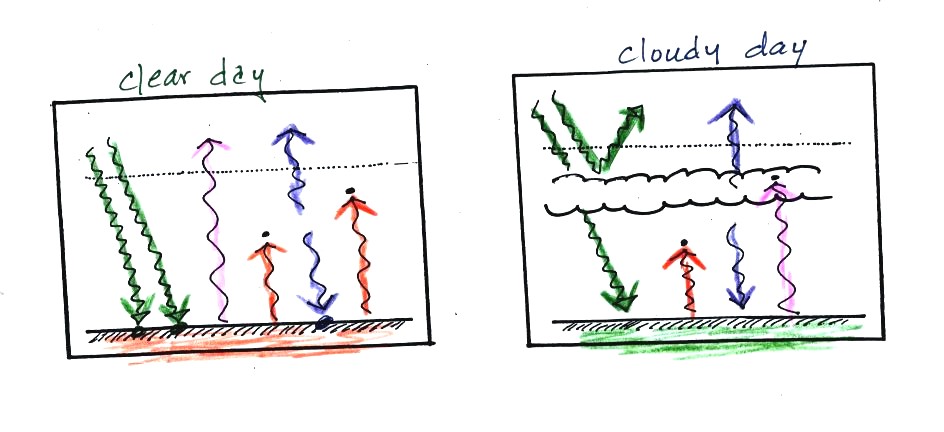
Clouds are good reflectors
of visible
light. The effect of this is to
reduce the amount of sunlight energy reaching the ground in the right
picture. With less sunlight being absorbed at the ground, the
ground
doesn't need to get as warm to be in energy balance.
It is generally cooler during the day on a cloudy day than on a clear
day.
Clouds raise the nighttime minimum temperature and lower the daytime
maximum temperature.

Typical daytime highs and nighttime lows in Tucson for this
time of year. Note how the clouds reduce the daily range of
temperature.
We'll use
our simplified representation of radiative equilibrium to understand
enhancement of the greenhouse effect and global warming.

The figure (p. 72c in the photocopied Class Notes) on the
left
shows
energy balance on the earth
without
an atmosphere (or with an atmosphere that doesn't contain greenhouse
gases). The ground achieves energy balance by emitting only 2
units of energy to balance out what it is getting from the sun.
The ground wouldn't need to be
very warm to do this.
If you add an atmosphere and greenhouse gases, the atmosphere will
begin to absorb some of the outgoing IR radiation. The atmosphere
will also begin to emit IR radiation, upward into space and downard
toward the ground. After a period of adjustment you end up with a
new energy balance. The ground is warmer and is now emitting 3
units of energy even though it is only getting 2 units from the
sun. It can do this because it gets a unit of energy from the
atmosphere.
In the right figure the concentration of greenhouse gases has increased
even more (due to human activities). The earth would find a new
energy balance. In this case the ground would be warmer and would
be emitting 4 units of energy, but still only getting 2 units from the
sun. With more greenhouse gases, the atmosphere is now able to
absorb 3
units of the IR emitted by the ground. The atmosphere sends 2
back to the ground and 1 up into space.
The next figure shows a common misconception about the cause of global
warming.

Many people know that sunlight contains UV light and that
the ozone
absorbs much of the dangerous type of high energy radiation.
People also know that release of chemicals such as CFCs are destroying
stratospheric ozone and letting some of this UV light reach the
ground. That is all
correct.
They then conclude that it is
this additional UV energy reaching the ground that is causing the globe
to warm. This
is not correct. There isn't much UV light in sunlight in
the
first place and the small amount of additional UV light reaching the
ground won't be enough to cause global warming. It will cause
cataracts and skin cancer and those kinds of problems but not global
warming.
Next up in
NATS 101 - Causes of the seasons
This new material won't be covered on Quiz #2
First some very basic information (that every college graduate should
know)

Many people would have missed the 3rd question. Many
people think
the moon orbits the earth in about a day. This is because they
see it in about the same position in the sky on successive
nights. We can see what actually happens in the next figure (not shown in class)

On the
first night in Fig. A the person looks up and sees the moon. One
day later on
night B, the earth has completed one rotation on its axis and the
person
is looking up at the same point in space. The person doesn't see
the moon in the same position as the night before; the moon has moved a
little bit in its orbit. In Fig. C, a little more than 24 hours
after Fig. A, the person again sees the moon overhead. If you
were to make a note of the time the moon rises you would notice it
rises a little later each successive night.

Many people know that the earth's orbit around the sun is
not circular and that the distance between the earth and sun changes
during the year. Many people think this is the main cause of the
seasons. The earth is closest to the sun on the perihelion,
furthest on the apehelion.
The earth is closer to the sun in January than in
July. If
this were the main cause of the seasons, summer in Tucson would be in
January and winter would be in July. Summer and winter would both
occur at the same times in both hemispheres. Neither of these is
true. The changing
distance
between the earth and the sun has an effect but is not the main cause
of seasonal changes.
The main cause of the seasons is the fact that the earth is tilted with
respect to its orbit around the sun. This is shown in the next
figure.
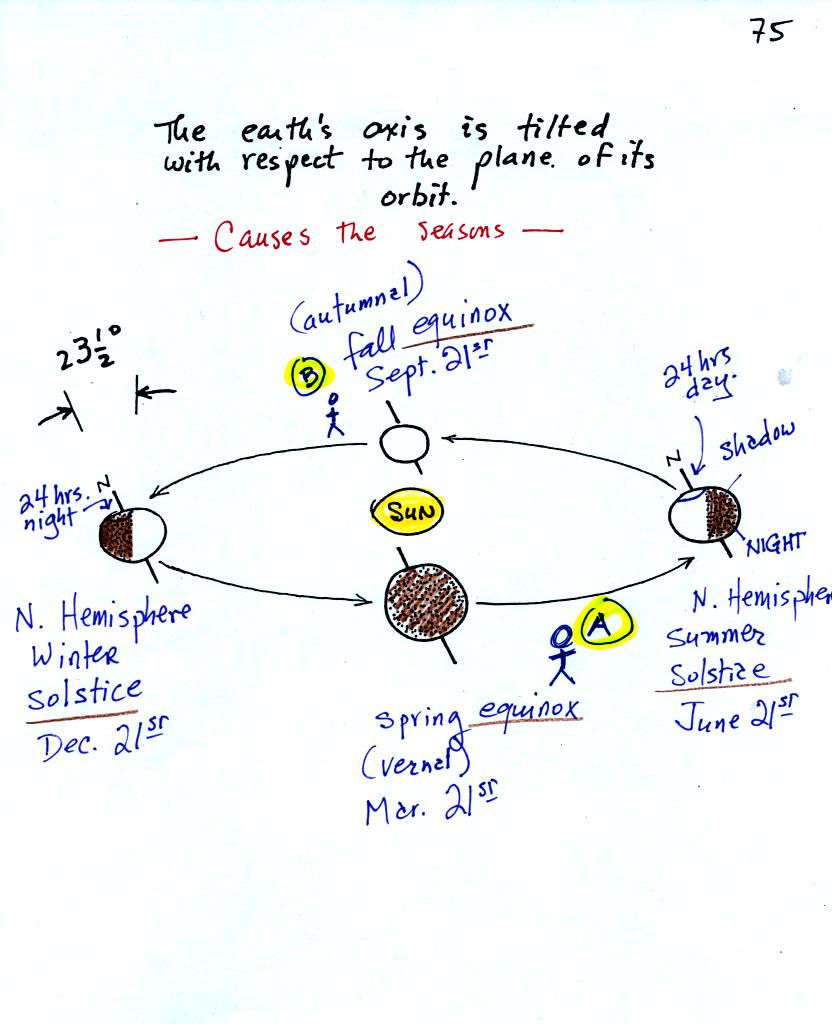
This figure shows the tilted earth at four locations in its
orbit around the sun. You should be able to start with a blank
sheet of paper and
draw a
picture like this. Note how the N. Pole tilts away
from the sun
on Dec. 21st, the winter solstice. The N. Pole is tilted toward
the sun on June 21. Those are good places for you to
start your sketch. You should also be able to name and attach a
date to each of the four locations.
Before going on, try to imagine what this picture would like if instead
of standing at Point A you
moved to the other side of the scene and looked back toward the
sun from Point B. This
possibility wasn't covered in class. Click here for a
sketch.
Seasons on the earth are caused by the changing orientation of the
earth relative to the sun. The figure above doesn't really
explain why this is true.
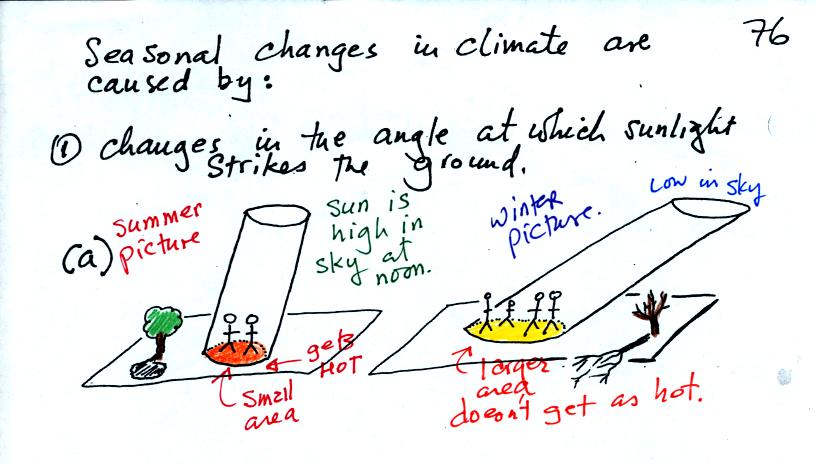
In the summer when the sun reaches a high elevation angle
above the
horizon, an incoming beam of sunlight will shine on a small area of
ground. The ground will get hot. The two people sharing the
shaft of summer sunlight will get a sunburn.
In the winter the sun is
lower in the sky. The same beam of sunlight gets spread out over
a larger area. The energy is being used to try heat a larger
amount of ground. The result is the the ground won't get as
hot. 4 people are able to share the winter sunlight and won't get
burned as quickly.
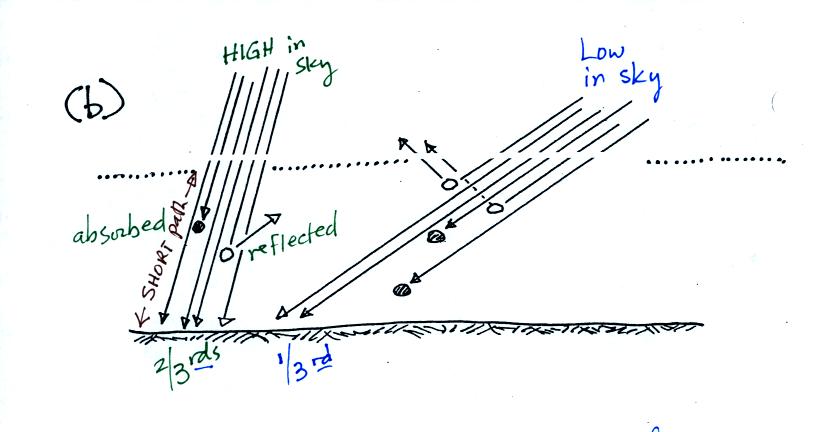
As sunlight passes through the atmosphere it can be absorbed
or
reflected. On average (over the globe) only about 50% of the
sunlight arriving at
the top of the atmosphere actually makes it to the ground. A beam
of sunlight that travels through the atmosphere at a low angle (right
picture above) is less intense than beam that passes through the
atmosphere more directly (left picture).

The sun shines for more time in the summer than in the
winter. In
Tucson the days (daylight hours) are around 14 hours long near the time
of the summer
solstice. In the winter the sun only shines for 10 hours on the
winter solstice. Days are 12 hours long on the equinoxes.












